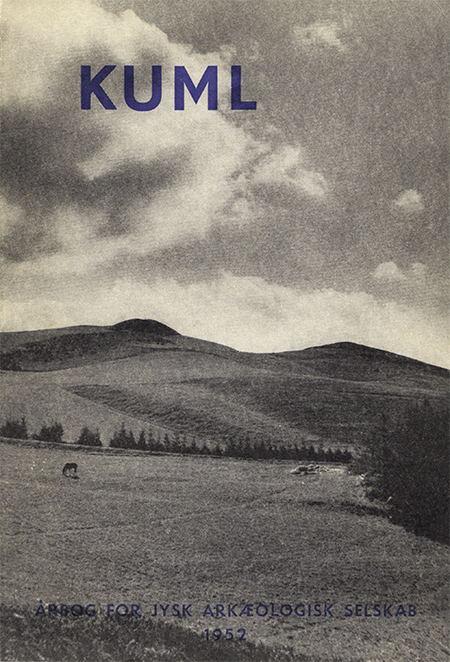Gravfund fra Borritshoved
DOI:
https://doi.org/10.7146/kuml.v2i2.24899Nøgleord:
Borritshoved, gravResumé
Glass and Bronze Vessels from a Grave at Borritshoved on Zealand
The extensive trade during the first five centuries of our era between the Roman Empire and Scandinavia is illustrated by the discovery of a grave at Borritshoved on Zealand containing glassware imported from the Empire, probably from a Rhineland glass foundry.
The grave lay within a stone circle of about 11 meters diameter, within which was a layer of large stones (fig. 1) surrounding an inhumation grave lying NNE-SSW, 3.5 meters long by 1.75 meters wide (fig. 2).
At the bottom of the grave the grave furniture was found on the remains of a wooden coffin. 0.25 meters from the southern end and close to the eastern side of the grave were three glass cups (fig. 3) in a row, all with mouth upwards. Other finds comprised a decomposed silver fibula, a fragmentary bronze ladle with a strainer in position (fig. 4), a plain spiral-formed gold finger ring (fig. 5), a big bronze bowl (fig. 6), completely shattered but still showing evidence of having stood right way up, and the almost completely decomposed sherds of a pottery vessel (fig. 7). In addition, clear impressions of a row of animal teeth were found and, about 0.15 meters from the southern end, the distinct impression of a set human teeth with remnants of the enamel preserved.
The fibula and the bronze bowl are too fragmentary to be datable, while the pottery vessel and the gold finger-ring are of types well-known from the Late Roman Iron Age and later, but difficult to place more exactly. The bronze ladle and its strainer, however, can be identified with certainty.
The most interesting and also the best preserved specimens are the three glass cups. They are of different sizes but all of the same type, which may be described as a cylindrical cup with a low foot, a type to which the famous painted glass cups from Varpelev, Torslunde, Nordrup and Himlingøje belong. Another specimen of the type (fig. 8), but without decoration, was found in Denmark in the same cemetery at Himlingøje as the painted cup just mentioned.
Among these glass cups it is possible to distinguish between a low and a tall variant where the proportion between height and rim-diameter (height-rim index H/R) is 0.75-0.88 and 0.69-0.72 respectively.
If we now attempt a relative placing of the tall and the low variants within the period of the Late Roman Iron Age, to which they both belong, two Danish finds may give some support. The one is the Nordrup grave A, the glass cups of which both belong to the tall variant, and the other is the Himlingøje grave with the painted glass cup of the low type. A fibula and a gold ring contained in the latter grave must on stylistic grounds be regarded as later than a fibula and a gold ring found in the former.
Accordingly, the Himlingøje grave must presumably belong to a rather later date than the Nordrup grave A, and consequently the tall variant of our glass cups is presumably earlier than the low one.
Three finds justify an attempt to reach an absolute chronology for the cylindrical glass cup in its tall and its low variants: a specimen of the tall variant (H/R = 0.75) was found during the excavation of Verulamium under conditions that allow dating to the years 160-190 AD; this agrees with the fact that a similar glass cup (H/R = minimum 0.8) was found in a grave at Cologne which is dated to the second half of the 2nd Century AD.
The other tall glass cups of this type known from outside Denmark - from Trier, Airlie in Angus, Westray in Orkney and Kingoldrum in Angus - give no help in dating.
The only find which may suggest an absolute date for the low variant is the grave from Himlingøje where an unpainted glass cup (fig. 8) was found inside a bronze dish with a spout and a cover of a type which seems hitherto only to have appeared in finds from the first half of the third Century AD.
Having seen that the tall variant of the cylindrical glass cup is the earlier, and that it may be adorned with paintings of circus contests, there seems to be reason to point out that the so-called Gallic circus cups with pictures in relief of contests in the arena, which had their origin in the second half of the 1st Century AD and which must be supposed to have inspired the painted glass cups found in Denmark, all seem to have a height-rim index which corresponds to the tall variant.
If we attempt now to date the Borritshoved grave on the basis of the above data we find that of the bronze vessels only the strainer and the ladle afford some guidance, and they only permit of a dating to the early part of the Late Roman Iron Age. The glass cups, however, which are all of the tall variant, date the find to the earliest part of the Late Roman Iron Age and also provide the basis of an absolute dating which, everything cautiously considered, should perhaps be put at about 200 AD.
Hans Norling-Christensen
Downloads
Publiceret
Citation/Eksport
Nummer
Sektion
Licens
Fra og med årgang 2022 er artikler udgivet i Kuml med en licens fra Creative Commons (CC BY-NC-SA 4.0).
Alle tidligere årgange af tidsskriftet er ikke udgivet med en licens fra Creative Commons.


